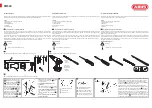
17
installation
&
operation
manual
|
dlv
heating
system
5.2.12 RESISTANCE TEMPERATURE DEVICE (RTD)
WARNING
!
Hazardous voltage:
Before wiring, servicing or cleaning
the heating system, turn off the power and follow your
organization’s lockout and tagout procedure. Failure to do so
could allow others to turn on the power unexpectedly, resulting
in harmful or fatal electrical shock.
High-limit or control resistance temperature devices (RTDs)
sense temperature to either control fluid temperature or protect
the system and fluid from overheating. To replace a resistance
temperature device (RTD), use the following procedures.
OOE:
Before removing and replacing an RTD, ensure the RTD is
malfunctioning.
See
SECOIO 5.2.11
.
1.
De-energize the heating system. Allow fluid to cool.
2.
Close isolation valves. Drain the fluid from the oil or
coolant heating tank. Locate the RTD that requires
replacement.
See Fig. 9
.
3.
Unscrew RTD plug. Remove plug.
See Fig. 10
.
4.
Unscrew RTD from tank.
See Fig. 11
.
5.
Screw replacement RTD to tank. When tightening, ensure
plug is aligned with notch toward top of tank.
See Fig. 12
.
6.
Fit RTD plug to RTD. Ensure plug is aligned correctly
with notch. Push plug in firmly. Screw RTD plug to RTD to
secure in place.
7.
To ensure proper installation and temperature regulation,
re-energize and operate heating system.
Refer to
SECOIO 4
for system start-up procedures.
RTD PLUG
Figure 12. Proper RTD
orientation. Note the notch
centered at the top of the
RTD connection.
Figure 10. RTD
plug. Unscrew
plug and remove
to disconnect RTD
prior to removal.
Figure 9. High-
limit and control
RTDs for coolant
and oil heating
systems. High-
limit RTDs are
located near
the tank outlets;
control RTDs are
located near the
tank inlets.
HIGH-LIMIT
RTD
CONTROL
RTD
Figure 11. RTDs
shown removed
from tank
assemblies.





































